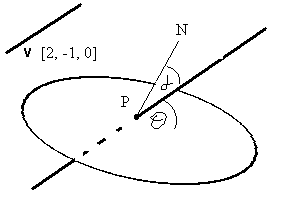Problem: |
||
| A diagram of this is shown on the right. |  |
v is the vector to which the line is parallel. P is the point of intersection of the line and plane. N is the normal to the plane through P. θ is the angle between the line and plane. α is the angle between the normal and the line. |
| The angle, α, between the normal and the line can be easily found using 'the angle between two lines' method. The required angle, θ, is then the difference between α and one rightangle.
From the equation to the given plane, r.[3, 0, 4] = 5, the normal to the plane is parallel to the vector [3, 0, 4]. The line is parallel to the vector [2, -1, 0].
|
||